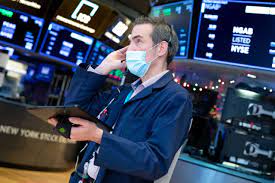The blue-chip Dow Jones Industrial Average edged up to another record close Wednesday, despite concerns about rising inflation and the eventual withdrawal of flush monetary policy as the economy reopens in the wake of the pandemic, though technology stocks fell for a fourth straight day.
Market participants also parsed dovish comments from Fed staffers and economic data showing a healthy economic recovery.
What drove the market?
The Dow touched a intraday and closing record Wednesday, as stocks outside of the tech sector recovered some of Tuesday’s losses, helped by better-than-expected corporate earnings reports and some supportive economic data.
But the prospects of an eventual withdrawal of pandemic-era liquidity from the Federal Reserve also weighed on the market.
“If you think about the last year, its been highly accommodative monetary policy across the board, with aggressive fiscal stimulus to fight the pandemic,” said Matt Stucky, an equities portfolio manager at Northwestern Mutual.
Those things were “right to do,” Stucky said, but added that investors have been coming to grips with the notion that crisis-levels of liquidity are unlikely to last forever.
“It’s not just today and yesterday, it’s been a factor for the last couple of weeks,” he told MarketWatch.
The overall message from Fed staffers on Wednesday was to expect the go-slow strategy to continue, and that more healing needs to happen in the economy before the central bank will consider reducing its extensive support for markets.
Cleveland Fed President Loretta Mester said the job market will need to make further improvements before the Fed’s conditions for reducing its support are met, while speak Wednesday at the Boston Economic Club.
Boston Federal Reserve President Eric Rosengren said that temporary factors will push measured inflation higher this spring, but the distortions won’t last long, echoing comments made Wednesday by Chicago Fed President Charles Evans.
Investors also were focused on economic data, with the Institute for Supply Management reporting growth in service-oriented businesses, such as retailers, restaurants and healthcare providers slipped to 62.7% last month from 63.7% in March.
That contrasts with an increase in the IHS Markit service sector purchasing managers index for April to 63.5, up from 59.7 in March, marking the sharpest upturn in private sector output since data collection began in October 2009, the data-provider said.
On the jobs front, the U.S. gained 742,000 private-sector jobs in April, according to data from Automatic Data Processing, below the 800,000 increase economists polled by The Wall Street Journal and Dow Jones expected.
Still, the labor-market reading was seen as strong and unlikely to derail Friday’s possibility of a 1 million print for nonfarm payrolls gains for April from the U.S. Labor Department, some analysts said.
“While the ADP read may have come in lower than expectations, keep in mind this is the highest number we’ve seen since the beginning of the fall,” said Mike Loewengart, managing director of investment strategy at E-Trade Financial, in emailed comments.
“So we’re definitely moving in the right direction. And with hospitality and leisure jobs leading the pack, we’re seeing proof that the economy is moving toward full reopening, albeit slightly slower than some expected,” the strategist added.
Fears that the economy may overheat and inflation may rise bubbled back to the surface Tuesday after Yellen, the former head of the Federal Reserve and now U.S. Treasury Secretary, suggested that interest rates may need to rise to prevent prices from rising too quickly. However, Yellen clarified her remarks to say she wasn’t predicting nor recommending that the Fed raise rates, while speaking at an event hosted by The Wall Street Journal’s CEO Council Summit.
Analysts also pointed out that equity markets are trading near records and may be been vulnerable to a pullback, following a period of sustained gains as the public health crisis has eased in the U.S.
“Big tech has obviously been under a microscope for quite some time now. And with relatively high valuations, it’s not surprising to see investors looking for opportunities elsewhere,”E-Trade’s Loewengart told MarketWatch. “So with inflation fears reemerging, tech continues to have the potential to take the brunt of those jitters,” he said.
On the public health front, President Joe Biden on Tuesday announced a new goal of getting 70% of U.S. adults vaccinated with at least one COVID-19 vaccine dose by the Fourth of July, along with having 160 million adults fully vaccinated by that holiday.
The Biden administration on Wednesday said it backed waiving intellectual property protections for COVID vaccines, to “help end the pandemic,” after being urged by by lawmakers at home and governments abroad to aid poorer countries in the effort to produce generic versions of the shots as the global caseload soars. Shares of vaccine makers Moderna, Inc. MRNA, -6.19% closed 6.2% lower, while those of Pfizer Inc. PFE, +0.05% ended flat.
The 10-year Treasury note yield TMUBMUSD10Y shed 0.07 basis points to 1.584%.
The greenback was little-changed, at around 91.27, based on the ICE U.S. Dollar Index DXY.
Gold futures GC00 rose $8.30, or 0.5%, to settle at $1,784.30 an ounce on Comex. U.S. crude futures CL.1 fell 6 cents, or nearly 0.1%, to settle at $65.63 a barrel on the New York Mercantile Exchange, heading for a third straight gain.
In Asian trade, Hong Kong’s Hang Seng Index HSI fell 0.5%. Bourses in Shanghai and Tokyo were closed.
Source:-https://www.marketwatch.com/story/dow-futures-edge-higher-tech-sector-set-to-bounce-back-after-tuesday-selloff-11620214619




